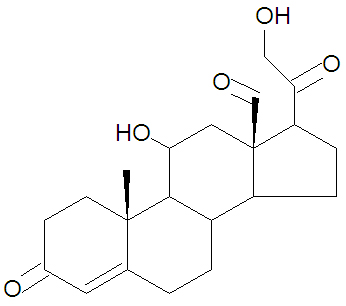Aldosterone: Difference between revisions
Jump to navigation
Jump to search

imported>David E. Volk (microstub with picture) |
imported>David E. Volk m (other name) |
||
| Line 1: | Line 1: | ||
{{subpages}} | {{subpages}} | ||
[[Image:Aldosterone DEVolk.jpg|right|thumb|350px|{{#ifexist:Template:Aldosterone DEVolk.jpg/credit|{{Aldosterone DEVolk.jpg/credit}}<br/>|}}Aldosterone, a [[mineralcorticoid]] [[steroid]].]] | [[Image:Aldosterone DEVolk.jpg|right|thumb|350px|{{#ifexist:Template:Aldosterone DEVolk.jpg/credit|{{Aldosterone DEVolk.jpg/credit}}<br/>|}}Aldosterone, a [[mineralcorticoid]] [[steroid]].]] | ||
'''Aldosterone''' is a [[steroid]] [[hormone]]. It is the major [[mineralcorticoid]] and it therefore controls [[electrolyte]] levels, [[blood pressure]] and hydration. Aldosterone is synthesized from [[corticosterone]] by oxidation of the C-18 methyl group to form an aldehyde. | '''Aldosterone''', also called '''(11ß)-11,21-Dihydroxy-3,20-dioxo-pregn-4-en-18-al''', is a [[steroid]] [[hormone]]. It is the major [[mineralcorticoid]] and it therefore controls [[electrolyte]] levels, [[blood pressure]] and hydration. Aldosterone is synthesized from [[corticosterone]] by oxidation of the C-18 methyl group to form an aldehyde. | ||
Revision as of 14:34, 5 January 2008
Aldosterone, also called (11ß)-11,21-Dihydroxy-3,20-dioxo-pregn-4-en-18-al, is a steroid hormone. It is the major mineralcorticoid and it therefore controls electrolyte levels, blood pressure and hydration. Aldosterone is synthesized from corticosterone by oxidation of the C-18 methyl group to form an aldehyde.
